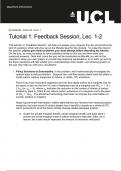Lecture notes
ECON0050 - Economics of Public Sector All 10 Weeks Resources
- Institution
- University College London (UCL)
I have a merged PDF of all Lecture notes for all 10 weeks of content public sector module. All tutorial solutions for practice for the exam. A structure for the essay coursework
[Show more]



